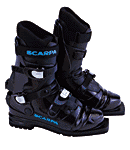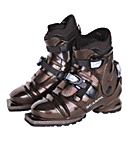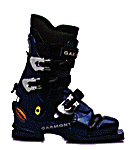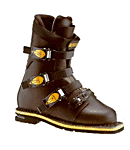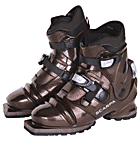 Plastic Tele Boots
Plastic Tele BootsDuel Injected Wave of the Future Telemark's wave of the future has ebbed. Six years after the initial introduction of a plastic telemark boot, manufacturers are refining boot design and are churning out a product that gives the consumer more reasons to buy plastic. The plastic revolution began in 1991, when Black Diamond Equipment's Scarpa division unleashed the Terminator, the greatest innovation for telemark skiers since cable bindings. The Terminator promised the power that leather boots lacked, thereby enabling tele skiers to incorporate alpine ski techniques into their runs. Those skiers armed with plastic laughed in the face of crud, bumps and hardpack and enjoyed lighter set-ups and warmer feet. Plastic's torsionally rigid sole allows efficient transfer of energy to the ski edge for better holding power and the rigidity of the plastic upper transfers power from skier to board more efficiently. But there is a downside to plastic as well. Plastic's rigidity hampers ski feel and past boot designs worked the flex point of the boot into an area that may not have been to everyone's liking. Despite these complaints, plastic has developed a following, so much so that Scarpa has been joined by Asolo and Garmont. These three types of plastic boot technology took hold of the market. Asolo's boots are plastic injected and feature a mechanical hinge, supported by a flex plate. Scarpa's line, in comparison, are plastic injected — flex points are molded into the boot and Garmont's latest line is made with double-injected plastic, using two densities of plastic with the flex points molded into the boots.
Scarpa's line has some die-hard followers. Over the past six seasons, the Terminator family has grown to three versions with the T1 ($515), the newly re-released T2 ($469) and T3 ($368). Craig Hatton, product manager for Black Diamond/Scarpa, said the Terminator was, and still is, targeted to tele-skiers who ski 80% in area and 20% backhill. After tweaking the T1 for a couple of seasons, Scarpa brought out the T2 in 1994-1995 and aimed it at the same skier, basically, as the T1. That left a huge hole where the backcountry afficionado sat, and Scarpa brought out the T3, specifically targeted at backcountry touring, in 1996-1997. Scarpa is reintroducing the T2 for this season as a middle ground between the T1 and T3.
The T2 borrows on the strengths of the T1 and T3. Backcountry tele-skiers will like the way it hikes now and you can make the cuff shorter by adjusting the power strap. But if you want it to feel as responsive and stiff as the T1 for the descent, you can if you change a few buckle closures, adjust the tongue and inner liner and wrap around the power strap. "We've already seen huge success with this boot - we really nailed it," Hatton said. It's rumored the T1 will be revamped for the winter of 1998-1999 and a modified T1, the Predator, may be released for racing. It's important to note that Scarpa debuted the T3 in a women's last this past season. The renovated T2 is also available in women's sizes this season.
Garmont began its commitment to plastic telemark boots in the winter of 1995-1996. Paul Parker was brought on just in time to tweak the first effort at double-injection plastic tele-boots this past spring. The principle of the double-injection manufacturing is this: when one material is injected over the top of another in certain areas of the boot, the flex is much improved and feels more like a broken-in leather boot. "My main priorities in the boot line were ensuring overall fit, flex where you want it, stiffness where you don't, liner fit and buckle positioning," Parker said. "The most important thing about the line is the double-injected plastic. Plastic tele boots have to be flexible forward yet rigid torsionally and that's a difficult goal," he said. Garmont's national sales manager, Gary Richter, agreed. "Different parts of the foot and different styles of turns require that different parts of the boots work separately. We had to have soft, medium and firm injections. We've come miles from earlier plastic boots — this is the next generation." Garmont addressed a major complaint — skiers like to feel the terrain and with some boots, the ski feel just isn't there. The new technology is found in the Veloce ($450), Women's Veloce ($450), the beefier backcountry friendly Gara ($500) and the super beefy Gara Comp ($570). Garmont's Women's Veloce is not just a "pinked" version of the Veloce. "Female telemark skiers are not fru-fru," Parker said. "We made this boot every bit the same as the men's only on a women's last."
For those of you wondering about what's out from Asolo, the company has shipped in limited quantities of the Tele Breeze Plus for this season. Asolo's national sales manager Stu Coulter, who works at Benetton Sportsystem's New Jersey headquarters, said that the Asolo officials decided to bring back a well-known leather tele boot this season — one that was taken out of the line when the company introduced plastic — the Extreme Racer. The Extreme Racer, $449.95, is an all buckle, leather, racing boot. Coulter said that its reintroduction has been well received and takes that early reaction as an indication that leather telemark boots may hoard more of the tele marketplace in seasons to come. That leaves the consumer with two clear competitors and some other high end niche manufacturers in choosing a plastic boot. — Kristen Carpenter, Mountain Zone Contributor
|
||||
 From The Mountain Zone Bookstore From The Mountain Zone BookstoreThe Mountain Zone Bookstore is now featuring "Free-Heel Skiing" by Paul Parker and over 3,000 other books, guides, videos, and software packages on working and playing in the mountains. | ||||
 From The Mountain Zone Gear Accessory Store From The Mountain Zone Gear Accessory StoreThe Mountain Zone Gear Accessory Store is now featuring the Petzl Micro Headlamp and all the other stuff that will make or break your trip. Glacier glasses, compasses, headlamps, telemarking poles and everything from amphibian knives to mosquito coil repellents. The stuff you need, available online. | ||||
Go back to Gear Review
